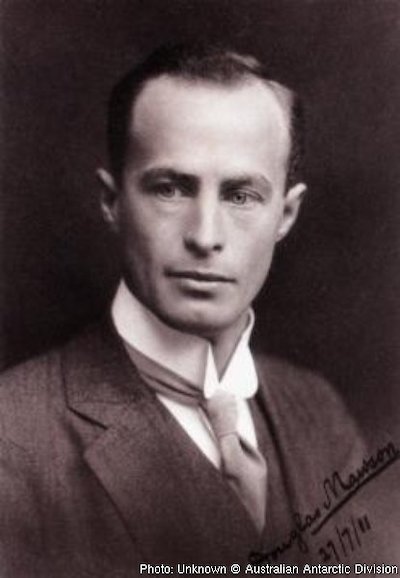Douglas Mawson
AAE position: Commander, leader of Australasian Antarctic Expedition, leader of Main Base, Cape Denison
In 1907 Douglas Mawson was an ambitious young geologist seeking academic glory by studying the rocks of Broken Hill when he was contacted by his former teacher, Professor TE David of the University of Sydney. David wrote about a forthcoming Antarctic expedition led by an Irishman, Ernest Shackleton, who had been a member of Robert Scott’s team in his first attempt to reach the South Pole.
David’s message was to transform Mawson’s life. When Shackleton came to Adelaide in 1909 as part of a fund-raising drive through Australia, Mawson introduced himself and offered his services. He accepted Shackleton’s counter-offer of a paid position as physicist, and headed off to the icy continent for 15 months.
Though still in his twenties, Mawson came out of the Shackleton expedition as a leader and visionary. He was in the party that first climbed the active volcano, Mount Erebus, and became the de facto leader of a three-man party (including David, his old professor) that was first to reach the South Magnetic Pole.
Mawson’s story as leader of the Australasian Antarctic Expedition is now part of Australian folklore. He came back from Shackleton’s expedition determined on an Australian-based Antarctic venture of his own — even rejecting an offer from Robert Scott to be a principal scientific member of Scott’s Terra Nova expedition. Instead of heading for the South Pole, Mawson opted to investigate the unexplored Antarctic coast south and southwest of Australia.
From the perspective of Mawson’s original vision, the expedition was an outstanding success. After setting up a wireless and scientific base on Macquarie Island, Mawson’s team established 2 widely-separated Antarctic bases – at Cape Denison (2,670 km south of Tasmania) and on Shackleton Ice Shelf over 2,000 km to the west – undertaking well-recorded exploring ventures covering thousands of kilometres of Antarctic coast and hinterland.
From Mawson’s personal perspective there was a down side – a crevasse accident that killed one of his sledging companions, Belgrave Ninnis, the agonising death of the other companion, Xavier Mertz, and a horrendous solo journey back to Cape Denison. His delayed return was too late for his scheduled return by ship, so with a handful of his Cape Denison party he had to spend a second winter in Antarctica.
Mawson returned in 1914 to a hero’s welcome, a knighthood – and a marriage, to the woman to whom he had been engaged from before his departure in 1911, Paquita Delprat, daughter of a mining manager and entrepreneur. He immediately got to work to publish the expedition’s scientific results and raise funds to pay off its debts – an exercise interrupted by the outbreak of war in August 1914. In England, Mawson entered war service by supervising munitions and supply shipments, rising to the rank of major.
Returning to the University of Adelaide in 1919, Mawson was appointed Professor of Geology and Mineralogy, concentrating his scientific energies for the next 30 years on precambrian rocks and glaciation, undertaking work in the Northern Territory and the Flinders Ranges. Mawson remained with the University of Adelaide for 31 years, pioneering the study of radioactive minerals and publishing more than 100 research papers.
But Antarctica continued to demand his attention. He continued work on publication of the scientific outcomes of the expedition, the AAE Reports – a project that was to occupy him for 30 years. In 1929, Mawson’s strong advocacy of Australian involvement in Antarctic affairs resulted in his appointment to lead the British, Australian and New Zealand Antarctic Research Expedition.
BANZARE – a three-year program to study the marine life off East Antarctica and survey and map its coastline – was ship-based, with a light plane to map the coastline and Antarctic islands. The expedition produced 13 volumes of reports, mainly concerned with the Southern Ocean and its species and ecosystems. BANZARE’s geographical survey was the basis for Australia’s eventual claim to sovereignty over nearly half of the continent.
Mawson’s achievements are commemorated in Antarctica by a station named after him – the first permanent Australian station, established in 1954. He was one of the first Honorary members of the Geological Society of Australia, and is commemorated in the Mawson Lecture and Medal for earth sciences, awarded biennially by the Australian Academy of Science (AAS). He has appeared on Australian postage stamps and featured on the front of the $100 note from 1984 to 1996.
Mawson’s honours are legion. He was awarded the Royal Geographical Society’s Antarctic Medal (1909) and Founder’s Medal (1915); the King’s Polar Medal (2 bars); the Gold Medals of the American, Chicago and Paris Geographical Societies; the Bigsby Medal of the Geological Society of London (1919); and the Mueller Medal of the Australian and New Zealand Association for the Advancement of Science (ANZAAS) (1930). He was a foundation member of the Australian Academy of Science and president of ANZAAS from 1932–37.
When Sir Douglas Mawson died, aged 76, on 14 October 1958, he was accorded a state funeral. The Australian Academy of Science obituary described him as ‘a man in whom scholarship, leadership and courage were generously combined to make a great Australian’.

